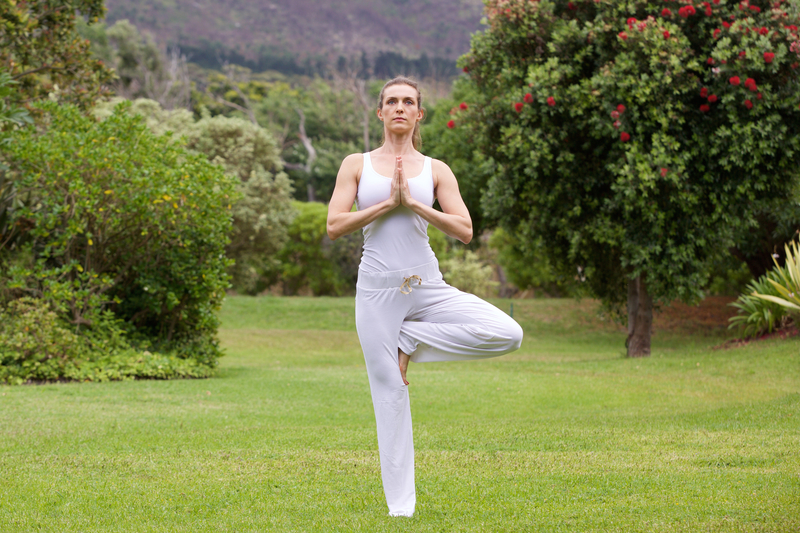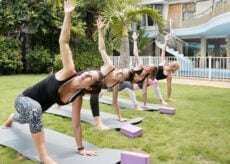How to Improve Balance As You Age with 5 Easy Exercises

I have a few quick questions for you: how confident are you when you stand on one leg? How about when you’re walking up stairs? Or trying a new exercise or activity?
Do you feel like you lack physical control? Do you think you would be more confident if you had better balance? Are there simple tips on how to improve balance?
Building better balance is important for many reasons. Not the least of which is that it makes it easier to move through life without injury. Especially as we age, we become more at risk for a variety of factors, including falls, which can be better prevented through an exercise program targeted at improving balance.
Fortunately, exercise provides many advantages not just for balance but for improved quality of life that comes from better balance.
For example, just the fear of experiencing a fall is enough to keep some folks sedentary. But, this doesn’t have to be the case for you. There are plenty of exercise routines you can follow, including ones you can easily do every day in the comfort of your own home that won’t cost you a cent, which I’ll describe later in this blog article.
In a study published in the Archives of Physical Medicine and Rehabilitation, researchers showed that a regular exercise program is essential when it comes to how to improve balance, stability, and self-confidence. Consistent exercise can help folks not only recover their balance, but can also help them recapture their confidence and autonomy. As they get stronger and regain control of their bodies and lives, the fear of falling becomes less prevalent, and their confidence in their ability to care for themselves is enhanced.
According to an article in the Journal of American Medical Women’s Association, not only is an overall regular exercise program crucial for health and wellness, but a program which focuses on leg strength in particular is most important if your goal is to improve your balance.
How Good Is Your Balance?
Chances are good that you already know if your balance needs improvement. But there are a number of tests that can help you determine the extent of your balance issues and where you may need to focus your efforts for improvement. For example, the Berg Balance Scale, Get-up and Go, Functional Reach, and Wall-Sit Tests all provide information on how to improve balance.
These tests can be especially helpful when it comes to showing your progress as you improve your balance. Start with a baseline balance test before starting your exercise routine, and then test again in another four to six weeks to assess your progress as well as focus on any areas that could use a little more work.
How to Improve Balance with 5 Exercises
Researchers say that while strength and cardiovascular training are important and should be done several times a week, exercises designed to improve your balance are even more critical and should be practiced every day.
So, how do you improve your balance with exercise? Here are five simple exercises that will give you a good start to regaining or improving your balance:
1. Sit-to-Stand—this exercise helps improve your leg strength as well as balance. Begin by sitting up straight in a chair with your knees bent at a 90-degree angle or a little less, with the heels of your feet under your knees at about hip-width apart or slightly wider. With your arms crossed in front of you, use your legs to slowly lift your body out of the chair until you reach a standing position. Return slowly to sitting to complete one repetition. Repeat for 10 repetitions.
2. Single-Leg Balance—begin by standing with your feet hip-width apart with your hands on your hips. Shift your weight to your left leg, and lift your right leg off the floor and hold it up for a count of ten. Return to the start and repeat on the opposite side.
3. Tai Chi Balance Moves—this form of martial arts is centered around slow and balanced movement and is excellent for strengthening your muscles and improving your overall balance. Taking a class is the best way to learn Tai Chi. But for a small taste, you can try this simple Tai Chi move at home. Begin by standing with your feet hip-width apart with your knees slightly bent. Bending your right knee, slide your right foot up the inside of your left leg until your foot is alongside your left knee. Slowly raise your hands out to your sides and hold this position for a count of five. Return to the start and repeat on the opposite side.
4. Lift-Off—while standing with your feet together and arms at your sides, slowly lean forward while lifting your right leg straight out behind your body and your arms straight out on either side of you with your head facing forward. Hold this pose for a count of 5 and return to the start. Repeat on the opposite side.
5. Lunges—this exercise will boost your balancing abilities while at the same time strengthening your legs, an important part of balance. Start by standing with your hands on your hips and your feet hip-width apart. Step forward with your right leg and bend both knees until the thigh of your forward leg is parallel with the ground and the knee of your back leg is bent at a 90-degree angle and is directly below your hip. Pause and push up through your heel to return to the standing position. Repeat on the opposite side. This completes one full repetition. Aim for five lunges with each leg, working up to this number gradually if you feel unsteady at first.
Note: You can make any of these exercises more difficult by either adding small hand weights or by performing them on an unstable surface like a Bosu ball or a pillow. Additional levels of difficulty can be added by performing the exercises without bracing yourself. And, if you’re feeling very balanced, you can even try these exercises with your eyes shut for added difficulty.
Spend just a few minutes every day with these simple exercises and tips on how to improve balance, boost your overall physical control and confidence, and increase independence.






